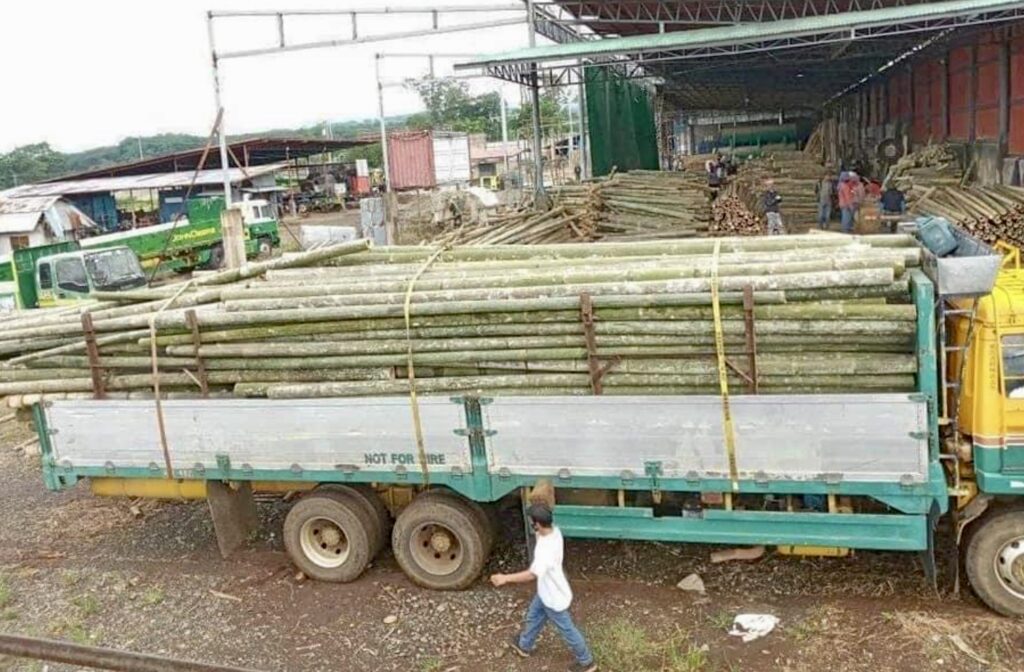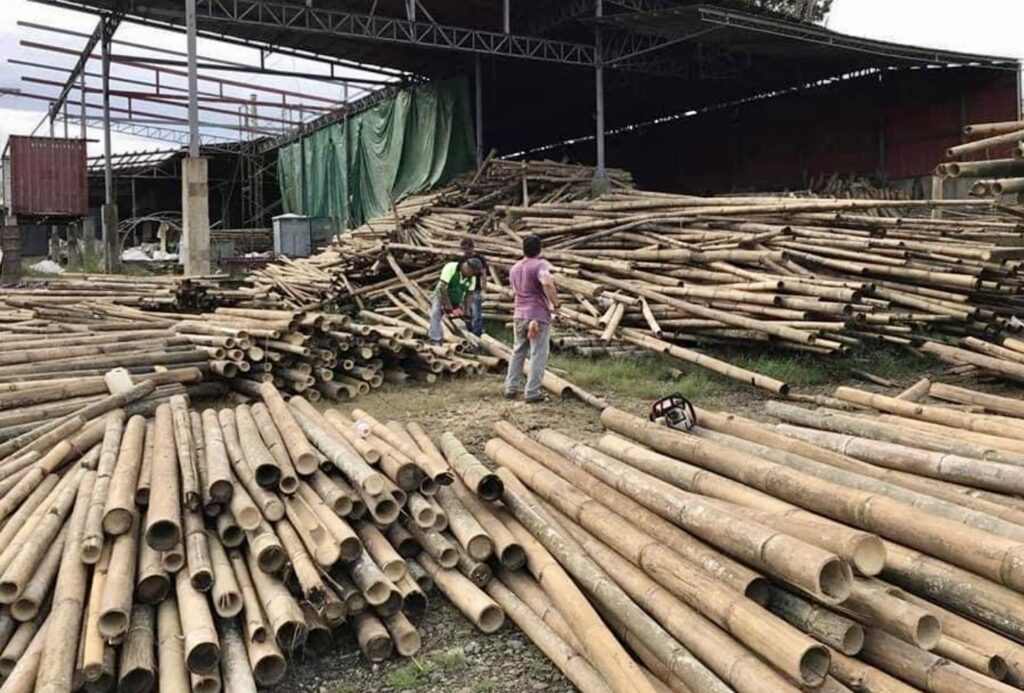Written by Henrylito D. Tacio
Filipino farmers could earn a net income of “as much as P200,000 per hectare” by planting giant bamboo. That’s what Secretary Emmanuel Piñol of the Mindanao Development Authority (MinDA) found out when he visited the Bukidnon Giant Bamboo Resourced Corporation recently.
“Farmer can make a profit of P200,000 per hectare per year, year after year with minimal maintenance cost (no replanting, fertilizer, etc.),” said the prospectus released by Mindanao’s first bamboo processing facility.
Several bamboo species grow in the Philippines but giant bamboo (known in the science world as Dendrocalamus asper) is the most preferred commercially. Other important species are kauayan-tinik, kauayan-kiling, bayog, botong, bolo, anos, and buho.
“What makes bamboo a versatile crop is its regenerative characteristic where several shoots grow to replace a harvested pole,” said Rod Bioco, the corporation’s president who sets up the bamboo processing facility in Malaybalay City.

Among the end products the corporation produced are treated and dried bamboo slats (intermediate raw material), laminated bamboo lumber/beams and boards, and finished products (like doors, jambs, mouldings and furniture).
“Most of these materials are now manufactured in China and imported by construction supply companies,” said Piñol.
Thus, growing giant bamboo is a profitable venture. The development cost up to three years of rearing is P50,000 per hectare (100 to 150 clumps). According to the prospectus, initial harvest can be started after 5-6 years but commercial harvesting starts in the seventh year. Poles should be 3-5 years old.
Farmers get a net income of P90-P120 per pole. The yield is 120-150 poles per hectare per year or around 120-150 metric tons per hectare per year. Some farms get 1,500 to 2,000 poles per hectare per year (15-20 poles per clump).
The prospectus said harvesting crew get P50-P80 per pole, depending on the terrain, thus generating an income of more than P8,000 per 16-metric truckload per 4-5 days per crew of 6-7 people.
Ideally, the supply is within 30-kilometer radius to control trucking cost (less than P50 per pole or P0.50 per kilogram). The plant capacity is 60,000 metric tons per year (two shifts) or 600,000 poles per year, which can be supplied from just 600 hectares of giant bamboo.
The buying price is P2.50 per kilogram on delivered/unloaded basis.
The production capacity, when finished, is 200 metric tons per day or 2,000 of fresh poles (3-5 years old at 40%mc) yielding 24,000 board feet per day. The investment is P150 million.
For dried, treated slats, they spent P55 per board feet and export them at P65 per board feet. “We sell engineered bamboo lumber or beams for P100 per board feet and panel boards for P120 per board feet,” Bioco said. “If we process them further into mouldings, floor panels, doors or jambs, we can sell for P180-P250 per board feet, while furniture can fetch P300-P500 per board feet.”
Bioco said they are hoping to sell more locally. “Every board foot of engineered bamboo is a board foot of a tree not being cut,” he pointed out.
In China, bamboo is one of the four noblest plants. The others are orchid, the plum tree, and of course the chrysanthemum. Bamboo plantations are so vast that they cover mountainous terrain.
All parts of the bamboo are utilized to produce sub-products such as foods, charcoal, bamboo fiber, and even bamboo beer. Thailand is one of its main buyers of bamboo charcoal while Japan purchases huge volumes of bamboo shoots.

The bamboo industry in the Philippines has the potential to grow “but it needs proper research and government support for it to prosper,” said Leonardo Avila III, when he was still alive and was the officer-in-charge of the Davao City Agriculture Office. “The bamboo industry can be another good source of livelihood to our local farmers in the next few years.”
Jethro P. Adang, the director of the Mindanao Baptist Rural Life Center (MBRLC) Foundation, Inc. in Kinuskusan, Bansalan, Davao del Sur, agrees. “We have an abundance of bamboo but we don’t know what to do with it,” he says. “It is so common that we ignore its potential. Other countries have already seen not only the beauty but the potentials of bamboo.”
Renowned furniture designer Kenneth Cobonpue from Cebu has seen that, too. In fact, he designed “Phoenix,” the world’s first and only car made from bamboo and rattan, which was showcased in a furniture fair in Milan recently.
The car, which looked like a bird about to take flight, was created in just 10 days with the use of bamboo, rattan, steel, and nylon. According to Inhabitat, an environmental web blog, “Phoenix” is designed to last the average length of time a person keeps a car – about five to 20 years.
There are so many potentials from bamboo. Furniture makers and wood craftsmen who shift from wood to bamboo are expected to share in the huge export bonanza expected from a growing demand for bamboo furniture and bamboo handicrafts in the global market.
“We’re not talking here of raw bamboo for export, but finished products made from bamboo. From roots to tip, you can make soap, medicines, cosmetics, furniture, bricks, clothing, paper, floor tiles, wall panels, drinks, vegetables – even surf boards from bamboo,” said an official from the Department of Trade and Industry.
There are a million uses of bamboo. According to an article, which appeared in Reader’s Digest, bamboo “is delicate enough to be used in phonograph needles, yet strong enough to be used in bridge construction.” As such, bamboo can replace or indirectly decrease consumption of three critically scarce resources: wood, metal, and oil.
Already, bamboo is being used as scaffolding and concrete reinforcement in the construction of buildings. In Bangladesh, where 73% of the population lives in bamboo houses, bamboo provides pillars, walls, window frames, rafters, room separators, ceilings and roofs. Throughout rural Asia it is used for building bridges, from the sophisticated technology of suspension bridges to the simpler pontoon bridges.
In the Philippines, bamboo is also indispensable in the fishing and banana industry. Fishermen likewise use bamboo as material for making rafts, fishing rods, outriggers for bancas, and for fishpens. In salt-water areas, bamboo is used as stakes in the culture of mussels and oysters.
Bamboo is also used in the manufacture of musical instruments like horns, clarinets, saxophones, flutes, piccolos, xylophones, and drums. In Java, Indonesia, 20 different musical instruments have been fashioned out of bamboo. The world-famous bamboo organ at the Roman Catholic Church of Las Piñas is a historic example of the importance of bamboo.
There are also sophisticated uses of bamboo – charcoal for electric batteries, liquid diesel fuel obtained by distillation, and enzymes and media for shoot extracts used for culturing disease-causing bacteria. The white powder produced on the outer space of young culms for the isolation of a crystalline compound is medically useful.

The young shoots are a good source of vitamins and minerals. Nutritionists claim that bamboo shoot is low in carbohydrates and crude fat, and it has plenty of crude fiber, making it an ideal vegetable for people who want to lose weight. Eighteen amino acids are reportedly present in bamboo shoots. Just a health warning: shoots of some species contain toxins that need to be leached or boiled out before they can be eaten safely.
Bamboo is a superb reforestation species due to its varied utility and importance in controlling soil erosion and stabilizing riverbanks. There are three main reasons why bamboo is a superb crop for cogonal areas: both bamboo and cogon belong to the same plant family and so are compatible; bamboo grows faster and taller than cogon, and can quickly shade out the later; and bamboo is not killed when the cogonal area is burned accidentally or deliberately.
The bamboo business is labor intensive, more so during the first two years of operation. Studies have shown that labor alone eats around 90 percent of the total production cost. But the beauty of bamboo growing lies in passing the first two critical growing years.
“If the bamboo survives, you are assured of money for the next 30 to 50 years,” says a bamboo grower. Another good thing: the price of bamboo does not suffer from severe fluctuations unlike pork and chicken. In fact, they are priced depending on the diameter, volume and distance traveled.
In the Philippines, bamboo grows anywhere. Often, it will grow on marginal farm areas not much good for anything else. “It is a pity that we have neglected this important crop for so long,” deplores Alimoane.
Unknown to many, bamboo is not a tree but a grass. It is a perennial grass belonging to the family “Gramineae.” It is considered near-relatives of rice, corn, wheat, oats, and barley. There are 75 genera and over 1,250 species in the tropical, sub-tropical and mild temperate regions of the world. In the Philippines, there are 12 bamboo genera consisting of 49 species.
Photos courtesy of BGB Resources

